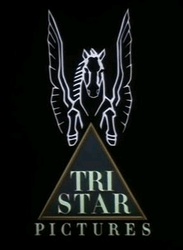TriStar Pictures
|
The current 2015 logo designed by JAMM Visual, commissioned by Sony. The first film to use it was The Walk. | |
| Division of the Sony Pictures Motion Picture Group[1] | |
| Industry | Film |
| Founded | 1982 |
| Founder | Victor Kaufman |
| Headquarters | Culver City, California, U.S. |
Key people |
Steve McQuinn Randy Oswalt Lionel Scott |
| Products | Motion pictures |
| Owner | Sony |
| Parent | Sony Pictures Entertainment |
| Divisions | TriStar Productions |
| Website | www.sonypictures.com |
TriStar Pictures (spelled as Tri-Star until 1991) is an American film studio that is a division of the Sony Pictures Motion Picture Group,[1] owned by the Sony subsidiary Sony Pictures Entertainment.
History
The concept for TriStar Pictures was the brainchild of Victor Kaufman, a senior executive of Columbia Pictures (then a subsidiary of the Coca-Cola Company),[2] who convinced the studio, HBO, and CBS to pool resources and split the ever-growing costs of making movies, creating a new joint venture in 1982. On May 16, 1983, it was given the name Tri-Star Pictures (when the new company was formed and did not have an official name, the press used the code-name "Nova", but the name could not be obtained as it was being used as the title for the PBS science series[3][4]). It was the first new major Hollywood studio to be established since RKO Pictures was founded in 1928.[5]
The studio's first produced film in 1984 was The Natural starring Robert Redford. Their first release however, was the film, Where the Boys Are '84; a 1984 remake of the 1960 Metro-Goldwyn-Mayer picture, Where the Boys Are that was co-distributed on behalf of ITC Entertainment after Universal rejected it; the film was a commercial flop.[6] During this venture, many of Tri-Star's releases were released on VHS by either RCA/Columbia Pictures Home Video (now Sony Pictures Home Entertainment), CBS/Fox Video (now CBS Home Entertainment and 20th Century Fox Home Entertainment), or HBO Video. In addition, HBO would gain exclusive cable distribution rights to these films, and broadcast television licenses would go to CBS.[7]
CBS dropped out of the venture in 1985,[8] though they still distributed some of TriStar's films on home video until at least 1992. In 1986, HBO dropped out of the Tri-Star venture as well and sold half of its shares to Columbia Pictures.[9] The same year, Tri-Star entered into the television business as Tri-Star Television. It was formed when the studio joined forces with Stephen J. Cannell Productions and Witt/Thomas/Harris Productions and created a television distribution company called TeleVentures.
Columbia Pictures Entertainment era (1987–1989)
On December 21, 1987, Tri-Star Pictures, Inc. was renamed to Columbia Pictures Entertainment, Inc. when Coke sold its entertainment business to Tri-Star for $3.1 billion, also creating Columbia/Tri-Star by merging Columbia and Tri-Star. Both studios continued to produce and distribute films under their separate names.[10] On April 13, 1988, CPE spun off Tri-Star Pictures, Inc. as a reformed company of the Tri-Star studio.[11]
Sony era (1989–present)
In 1989, Columbia Pictures Entertainment, Inc. was acquired by Sony Corporation of Japan, who merged Columbia and Tri-Star, but continued to use the separate labels. On July 11, 1990, Tri-Star Pictures dissolved and sold its venture in TeleVentures to Stephen J. Cannell Productions and TeleVentures became Cannell Distribution Co. Most of the series and the Tri-Star film packages that were distributed by TeleVentures were transferred to Columbia Pictures Television Distribution. The Tri-Star film packages were transferred to Columbia Pictures Television Distribution.[12] Sony Pictures Entertainment later revived TriStar Television as a television production banner in 1991 and merged with its sister television studio Columbia Pictures Television to form Columbia TriStar Television on February 21, 1994.[13][14] Both studios continued to operate separately until TriStar folded in 1999 and CPT in 2001.
In addition to its own slate, TriStar was the theatrical distributor for many films produced by Carolco Pictures (the rights to only one of their films, Cliffhanger, has been retained by TriStar). TriStar also theatrically distributed some FilmDistrict movies.
Around summer 1998, SPE merged Columbia and TriStar to form the Columbia TriStar Motion Picture Group, but just like Columbia Pictures Entertainment, both divisions continued producing and distributing films under their own names.
TriStar was relaunched on May 13, 2004 as a marketing and acquisitions unit that had a "particular emphasis on genre films".[15] Screen Gems' executive vice president Valerie Van Galder was tapped to run the revive studio after being dormant.[16] However, the release of its 2013 film Elysium represents the label's first big-budget release since The Mask of Zorro in 1998.
The same year, former 20th Century Fox co-chairman Tom Rothman joined Sony Pictures and created TriStar Productions as a joint venture with existing Sony Pictures executives. The new TriStar will develop, finance and produce up to four films per year, as well as television programming and acquisitions, starting on September 1.[17][18][19] Sony's TriStar Pictures unit will be retained for "other product, including titles from Sony Pictures Worldwide Acquisitions", and will distribute product from the new TriStar.[20]
Logo


TriStar's logo of Pegasus (either stationary or flying across the screen), introduced in 1984, has become something of a cultural icon. The idea came about because of executive Victor Kaufman and his family's interest in riding horses. The original logo was created with the assistance of Sydney Pollack, who was an adviser at Tri-Star. The horse in that logo was the same one used in Pollack's film The Electric Horseman. The horse in said movie was dark, so Pollack transposed it to look white in the logo.[21]
The second logo was originally painted by Alan Reingold and debuted in 1992, along with sister studio Columbia Pictures, with both logos sharing a background of clouds.[22] The theatrical version was animated by Intralink Creative in 1993. The white stallion was shot in a hangar at the Santa Monica Airport, The wings were done by combining real white feathers and computer-generated-imagery then merged with Pegasus by computer morphing. The background is nighttime blue. The clouds were shot from the Haleakala Crater on Maui.[23]
In 2015, a new TriStar Pictures logo was made and debuted in The Walk. This time it was animated by JAMM VFX.[24]
The short TriStar theme, which accompanied the studio's logo, was composed by jazz musician Dave Grusin.[25] The theme was remixed in 1993 by Bill Johnson and again in 1998.
Parodies and references
The TriStar logo has spawned many parodies, such as:
- The 1990 TriStar film Look Who's Talking Too contains both a spoof and a reference to the logo. First, during the opening ident, Mister Ed–type noises are added by Bruce Willis. Later in the film, when Julie first walks, the TriStar theme plays.
- Mad About You, produced by TriStar Television, ended the 1993 episode "It's a Wrap" with Paul Reiser arguing with his producer. Paul tells Lou to show "...and then the stupid horse with the wings. That'll work.".
- The Family Guy episode "Petergeist" contains a parody of the original 1984 logo, where the character Joe Swanson (voiced by Patrick Warburton) takes the place of the Pegasus mascot.
- The 1991 TriStar film Another You, where the film's star, Richard Pryor, is freaking out off-camera as the Pegasus makes his approach in the opening ident. This is then followed by an off-camera noise of the Pegasus (presumably) crashing into a bunch of cans. Thus prompting Pryor to exclaim profanity as to what he just witnessed.
Filmography
See also
References
- 1 2 "Divisions - Sony Pictures". sonypictures.com. Retrieved 7 June 2015.
- ↑ "Victor Kaufman - Founding TriStar Pictures". Vimeo.
- ↑ "What's in a name". Broadcasting: 102. 1983-05-16.
- ↑ Palmer, L. (1998) "How to write it, how to sell it: everything a screenwriter needs to know about Hollywood" (pp. 232–235). St. Martin's Press, New York. ISBN 0-312-18726-2.
- ↑ Holt, J. (2011). Empires of Entertainment: Media Industries and the Politics of Deregulation, 1980–1996 (p. 46). Rutgers University Press, Piscataway, NJ, USA. ISBN 978-0-8135-5052-7.
- ↑ London, Michael. "Tri-Star Bows With a Universal Castoff". Sarasota Herald-Tribune (February 18, 1984).
- ↑ Prince, S. (2000) A new pot of gold: Hollywood under the electronic rainbow, 1980–1989 (p. 31). Charles Scribner's Sons, New York. ISBN 0-684-80493-X.
- ↑ "CBS Sells Stake In Tri-Star Inc.". The New York Times. Associated Press. 16 November 1985.
- ↑ Prince, Stephen (2002) [2000]. A New Pot of Gold: Hollywood Under the Electronic Rainbow. History of the American Cinema Vol. 10. Berkeley, Calif.: University of California Press. p. 31. ISBN 9780520232662. Retrieved August 13, 2013.
- ↑ KATHRYN HARRIS (September 2, 1987) Coke, Tri-Star Confirm Plans for $3.1-Billion Deal Los Angeles Times, Retrieved on August 8, 2013
- ↑ "State of New York Division of Corporations - Entity Search: Tri-Star Pictures, Inc.". Retrieved 5 August 2013.
- ↑ "IN BRIEF". Broadcasting: 110. 1990-07-16.
- ↑ "TriStar President Expected to Head Combined Unit". Los Angeles Times, February 11, 1994. Retrieved on June 28, 2012
- ↑ "EBSCO Host Connection" Feltheimer heads new Columbia TriStar TV connection.ebscohost.com, Retrieved on December 18, 2012
- ↑ "Sony Pictures – Corporate Fact Sheet". Sony Pictures Entertainment. Archived from the original on January 7, 2012.
The label will have a particular emphasis on genre films
- ↑ Claude Brodesser and Cathy Dunkley "Variety" takes flight again variety.com May 13, 2004, Retrieved on 4 April 2016
- ↑ Fleming, Mike Jr. Tom Rothman To Launch New TriStar Productions Label For Sony Deadline Hollywood (August 1, 2013).
- ↑ Faughnder, Ryan (August 1, 2013). "Tom Rothman teams with Sony Pictures to create TriStar Productions". Los Angeles Times.
- ↑ MICHAEL CIEPLY (August 1, 2013) Sony Hires Rothman to Head Revived TriStar Unit The New York Times, Retrieved on August 2, 2013
- ↑ "Industry News: Sony Pictures and Tom Rothman Launching TriStar Productions". ComingSoon.net.
- ↑ "Victor Kaufman – Creating the TriStar Logo". Vimeo.
- ↑ "ArtsWestchester’s Arts Exchange: Alan Reingold". Westchester. September 2013. Retrieved January 7, 2015.
- ↑ Suzan Ayscough "Variety" June 18, 1993 TriStar unveils new logo variety.com, Retrieved on January 7, 2015
- ↑ "JAMM VFX". www.jammvisual.com. Retrieved 2015-11-07.
- ↑ "Tri-Star Logo Theme by Dave Grusin". Most Popular Songs. Retrieved August 13, 2012.
External links
- Official Sony Pictures website
- TriStar Pictures at the Internet Movie Database
- at the Hollywood films
